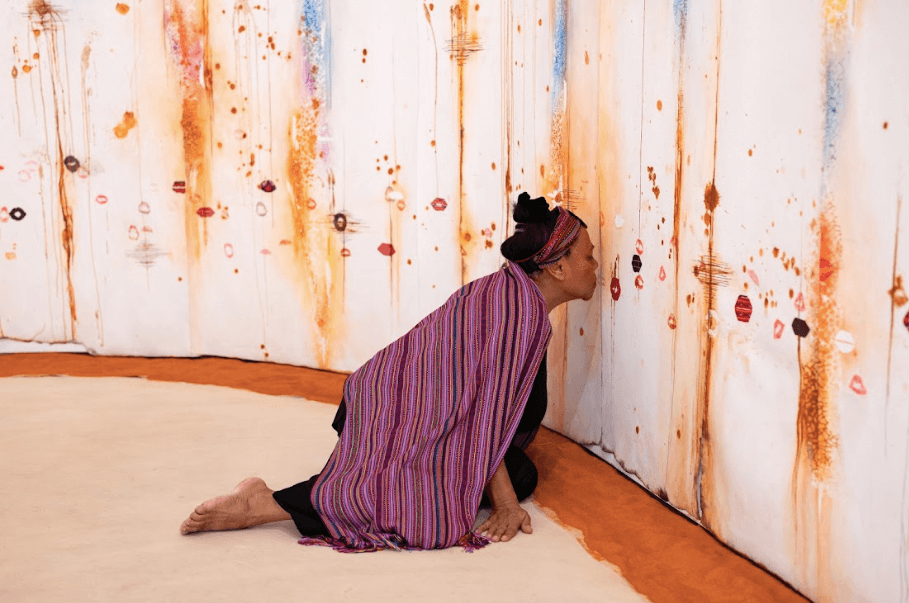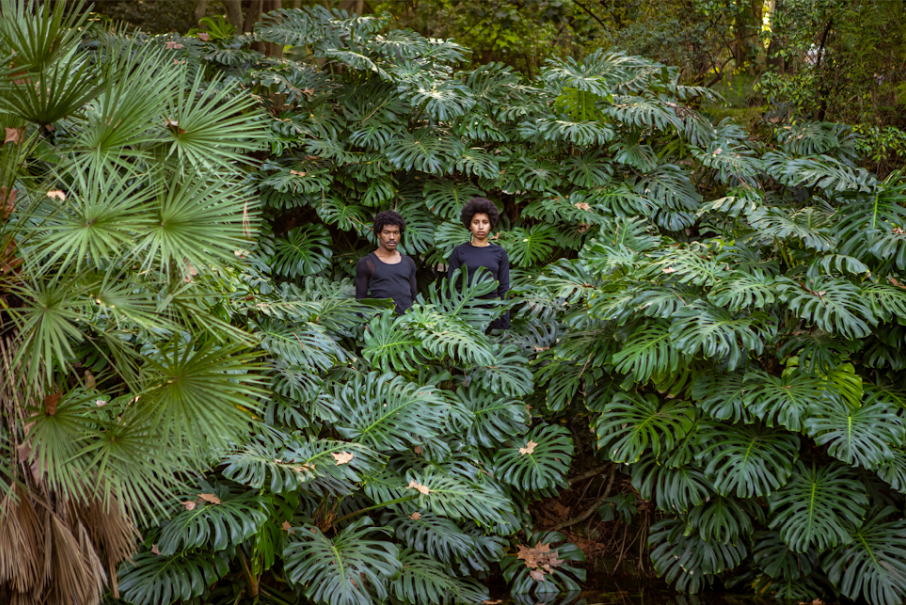Art as Activism: Cristina Baldacci, Natalie King and Francesca Tarocco on “Ina Lou / Dear Mother Earth” and the Call for Ecological Reverence at the Venice Biennale
Cristina Baldacci, Natalie King, Francesca Tarocco
Designed to create a vibrant dialogue across the Timor-Leste, Portuguese, and South-East Asian pavilions, the event draws together artists, curators, activists, and academics to explore shared themes of ecological reverence, cultural memory, and environmental activism. The symposium takes its title from a Timorese song, invoking a heartfelt call to Mother Earth and uniting diverse voices around issues of soil, water, and sovereignty. Through a cross-pavilion alliance, “Ina Lou/Dear Mother Earth” presents performances, film screenings, and discussions that address urgent concerns such as water rights, anti-colonial struggles, and the historical significance of maritime crossings. From the performance by Maria Madeira, “Kiss and Don’t Tell,” at Spazio Ravà and the living installation “Greenhouse” at Palazzo Franchetti to the thought-provoking film screenings at Ca’ Dolfin and the panel discussions at Ca’ Bottacin – headquarters of THE NEW INSTITUTE Centre for Environmental Humanities (NICHE) at Ca’ Foscari University of Venice – the symposium provides an immersive experience that invites attendees to reimagine humanity’s relationship with the planet and each other.
We speak with the organizers Cristina Baldacci, Natalie King, and Francesca Tarocco to learn more about the artistic vision, interdisciplinary collaborations, and urgent themes driving this unique event.

Teresa Sartore: “Ina Lou/Dear Mother Earth” draws from a traditional Timorese song invoking respect for the environment. How did this theme resonate with the vision for the symposium, and how does it connect the cultural practices of Timor-Leste with broader ecological and artistic discourse?
Natalie King: Everyone in Timor knows the traditional song “Ina Lou/Dear Mother Earth”, which is an invocation of the sanctity of Mother Earth. It is sung in the Indigenous language Tetum, and Maria Madeira, in her exhibition “Kiss and Don’t Tell”, performs this song while telling the haunting and harrowing story of the suffering of Timorese women as a result of the Indonesian occupation (1975-1999). Madeira honors these anonymous women in her site-specific, large-scale installation combined with her song from the time she was in a choir as a child growing up in a refugee camp on the outskirts of Lisbon. By drenching the walls in drips of paint and betel nut that resemble blood, further enhanced by the deep crimson hue of antiseptic, Madeira alludes to wounds and injuries. Given there are no art supply stores in Dili [the capital and largest city of Timor-Leste], Madeira deploys materials sourced locally by diluting the red ochre earth from her village Ermera co-mingled with threads of tais, the traditional Timorese textile. The effect is like a stain, teardrops, or even oozing blood. Pale hues of acrylic paint in blue and peach further add a luminous quality to her epic painting installation with a vibrating and pulsating effect, pleading to be seen. Madeira will perform and sing “Ina Lou/Dear Mother Earth” during the opening session of the symposium. We were keen to bind Timor-Leste with “Greenhouse” at Portugal, as a former colonizer of Timor-Leste, and link with the South-East Asian exhibition “The Spirit of Maritime Crossing”. NICHE, the Centre for Environmental Humanities at Ca’ Foscari University of Venice, is an incubator that cross-pollinates ideas and activities around ecological art practices, hosting us in Venice. Comprising panel discussions, film screenings, and a performance, this cross-pavilion event is a way to share critical discourse surrounding our respective pavilions while formulating collective trans-national responses. These kinds of gatherings are part of a practice of conversation, dialogue, friendship, support, alliance, and camaraderie.

TS: Many of the featured presentations and films in “Ina Lou/Dear Mother Earth” emphasize ecological art practices. How do you view the role of art in advocating for environmental justice, particularly within the intersecting issues of climate change, resource sovereignty, and Indigenous rights?
Cristina Baldacci: We have given much space to artistic practices, not only because the symposium is set in the context of the Venice Biennale, but mainly because we believe that artists should play an increasingly fundamental role within society, in the sharing of knowledges, visions, and lifestyles for the future. Artists pursue militant research that is concurrent with scientific/academic research and that should intertwine with it much more frequently than it usually does. We are very aware of this at NICHE, to the point that one of the ten research clusters of the Centre focuses on Ecological Art Practices – this gathering is part of the Art Ecologies series linked to it. In addition to Maria Madeira’s mourning and empowering ritual in the Timor-Leste pavilion, the tour inside the “Creole garden” of the Portuguese pavilion, and the exhibition on maritime diaspora at Palazzo Smith Mangilli Valmarana, the symposium features a series of film screenings at Ca’ Dolfin as one of its central moments of reflection. The artists’ films will address themes such as the desire for belonging, reconciliation with nature, sisterhood, anti-colonial and anti-patriarchal struggles (see Mónica de Miranda, Angela Tiatia, and Kaylene Whiskey), and the human/non-human relationship, expressed through contact with the elements – particularly earth and water – as a possible form of mental, bodily, and social healing (see Elena Mazzi, Antonio Rovaldi, and Ettore Favini). With an open and conscious approach, contemporary artists such as those involved in the symposium explore and challenge different fields of knowledge, encouraging critical thinking, emotional involvement, ethical responsibility, and collective imagination on urgent issues for the well-being and rights of “Mother Earth”.

TS: Could you tell us about the goals of NICHE and its influence on this symposium, especially in terms of integrating research, art, and public engagement?
Francesca Tarocco: In a remarkably short time, NICHE has established itself as an important global center of research excellence in the burgeoning field of Environmental Humanities. Further, it has laid the foundations for valuable engagements and knowledge-sharing with different groups in the local community and beyond. It has leveraged the beautiful university space it occupies at Ca’ Bottacin in Venice to create an exciting hub for the exploration of its themes, and it is welcoming both scholarly and creative approaches. NICHE hopes to have a significant impact on the vital global project of environmentally reparative thought and action by thoughtfully integrating arts practices and activities in its programming to make space for experimental and emergent forms of knowledge production, honoring and incorporating diverse ways of knowing beyond traditional, disciplinary, academic scholarship. Ultimately, the Centre seeks to play a bridging role between existing environmental studies knowledge silos. Its main goal is to take the lead in drawing connections and comparisons between existing fields and stimulating new ways of understanding ecosystems and our highly anthropized environment. We recognize that entangled in the environmental issues that face our global community are matters of human behavior, beliefs, and values, and that critical approaches to human-environment interactions past, present, and future, are essential. Since Venice is home to the international cultural exhibitions, Biennale of Art, Architecture, Music, and so on, it can form innovative collaborations with artists and other practitioners to create and sustain an international and collaborative network. We focus in particular on working with artists and performers who have an interest in co-producing environmental knowledge and action.
TS: How do you see the role of large-scale international events like the Venice Biennale evolving in response to the urgent need for environmental and social responsibility? How might such events continue to address and amplify themes like those explored in “Ina Lou/Dear Mother Earth”?
CB, NK, FT: The Venice Biennale is the oldest and most prestigious visual art event globally, but it’s important to note that it is held in the fragile lagoon habitat of Venice. We think it’s vital to consider our interdependencies as intertwinements within this context. The Venice Biennale is a place where we can gather, build relationships, and solidarities that lead towards a jointly sustainable future. The archipelago of Venice could be considered as a cultural microcosm and meeting place, as envisioned by Édouard Glissant from “…across the world that joins shores and horizons together.” We are striving for new ecologies of care for our environment and each other during troubled times by listening, talking, sharing, and being together. We are particularly interested in amplifying Indigenous voices and knowledge systems as well as ways of thinking from the Global South. Prior to “Ina Lou/Dear Mother Earth,” we organized, together with artist Yuki Kihara, who represented Aotearoa New Zealand at the Venice Biennale 2022 with the exhibition “Paradise Camp” [curated by Natalie King], the Venetian iteration of the Talanoa Forum, entitled “Swimming Against the Tide”. Talanoa is a pan-Pacific word that describes a process of inclusive, participatory, and transparent dialogue. Using talanoa as a point of conceptual departure, we initiated a trans-disciplinary and trans-cultural dialogue on queer rights, intersectionality, small island ecologies, oceanhood, and colonization, that we are still pursuing with much care and responsibility. We hope that, as a continuum, “Ina Lou/Dear Mother Earth” will be a meaningful gathering during the closing days of this year’s Venice Biennale.
To access the detailed programme for the “Ina Lou/Dear Mother Earth” symposium, scheduled for 19–20 November, you can download it directly from the following link: Download Programme PDF


